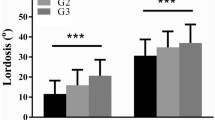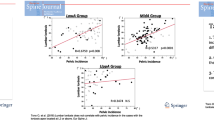Abstract
The analysis of the sagittal balance is important for the understanding of the lumbopelvic biomechanics. Results from previous studies documented the correlation between sacro-pelvic orientation and lumbar lordosis and a uniqueness of spino-pelvic alignment in an individual person. This study was subjected to determine the lumbopelvic orientation using pelvic radius measurement technique. The standing lateral radiographs in a standardized standing position were taken from 100 healthy volunteers. The measurements which included hip axis (HA), pelvic radius (PR), pelvic angle (PA), pelvic morphology (PR-S1), sacral translation distance (HA-S1), total lumbosacral lordosis (T12-S1), total lumbopelvic lordosis (PR-T12) and regional lumbopelvic lordosis angles (PR-L2, PR-L4 and PR-L5) were carried out with two independent observers. The relationships between the parameters were as follows. PR-S1 demonstrated positive correlation to regional lumbopelvic lordosis and revealed negative correlation to T12-S1. PA showed negative correlation to PR-S1 and regional lumbopelvic lordosis, but revealed positive correlation to HA-S1. T12-S1 was significantly increased when PR-S1 was lesser than average (35°–45°) and was significantly decreased when PR-S1 was above the average. PR-L4 and PR-L5 were significantly reduced when PR-S1 was smaller than average and only PR-L5 was significantly increased when PR-S1 was above the average. In conclusion, this present study supports that lumbar spine and pelvis work together in order to maintain lumbopelvic balance.




Similar content being viewed by others
References
Kobayashi T, Atsuta Y, Matsuno T, Takeda N (2004) A longitudinal study of congruent sagittal spinal alignment in as adult cohort. Spine 29:671–676
Barrey C, Jund J, Noseda O, Roussouly P (2007) Sagittal balance of the pelvis-spine complex and lumbar degenerative diseases. A comparative study about 85 cases. Eur Spine J 16:1459–1467
Legaye J, Duval-Beaupère G, Hecquet J, Marty C (1998) Pelvic incidence: a fundamental pelvic parameter for the three dimensional regulation of spinal sagittal curves. Eur Spine J 7:99–103
Vaz G, Roussouly P, Berthonnaud E, Dimnet J (2002) Sagittal morphology and equilibrium of pelvis and spine. Eur Spine J 11:80–87
Mac-Thiong JM, Berthonnaud E, Dimar JR, Betz RR, Labelle H (2004) Sagittal Alignment of the Spine and Pelvis During Growth. Spine 29:1642–1647
Mangione P, Gomez D, Sénégas J (1997) Study of the course of the incidence angle during growth. Eur Spine J 6:163–167
Marty C, Boisaubert B, Descamps H et al (2002) The sagittal anatomy of the sacrum among young adults, infants, and spondylolisthesis patients. Eur Spine J 11:119–125
During J, Goudfrooij H, Keessen W, Beker TW, Crowe (1985) A Towards standards for posture. Postural characteristics of the lower back system in normal and pathologic conditions. Spine 10:83–87
Duval-Beaupere G, Legaye J (2004) Composante sagittale de la satatique rachidienne (in French). Rev Rhum 71:105–119
Jackson RP (1997) Spinal balance, lumbopelvic alignments around the “hip axis” and positioning for surgery. Spine: State Art Rev 11:33–58
Jackson RP, Peterson MD, McManus AC, Hales C (1998) Compensatory spinopelvic balance over the hip axis and better reliability in measuring lateral radiographs of adult volunteers and patients. Spine 23:1750–1767
Roussouly P, Gollogly S, Berthonnaud E, Dimnet J (2005) Classification of the normal variation in the sagittal alignment of the human lumbar spine and pelvis in the standing position. Spine 30:346–353
Jackson RP, Kanemura T, Kawakami N, Hales C (2000) Lumbopelvic lordosis and pelvic balance on repeated standing lateral radiographs of adult volunteers and untreated patients with constant low back pain. Spine 25:575–586
Jackson RP, Hales C (2000) Congruent spinopelvic alignment on standing lateral radiographs of adult volunteers. Spine 25:2208–2215
Gardocki RJ, Watkins RG, Williams LA (2002) Measurements of lumbopelvic lordosis using the pelvic radius technique as it correlates with sagittal spinal balance and sacral translation. Spine J 2:41–49
Conflict of interest
None.
Author information
Authors and Affiliations
Corresponding author
Rights and permissions
About this article
Cite this article
Chanplakorn, P., Wongsak, S., Woratanarat, P. et al. Lumbopelvic alignment on standing lateral radiograph of adult volunteers and the classification in the sagittal alignment of lumbar spine. Eur Spine J 20, 706–712 (2011). https://doi.org/10.1007/s00586-010-1626-0
Received:
Revised:
Accepted:
Published:
Issue Date:
DOI: https://doi.org/10.1007/s00586-010-1626-0




